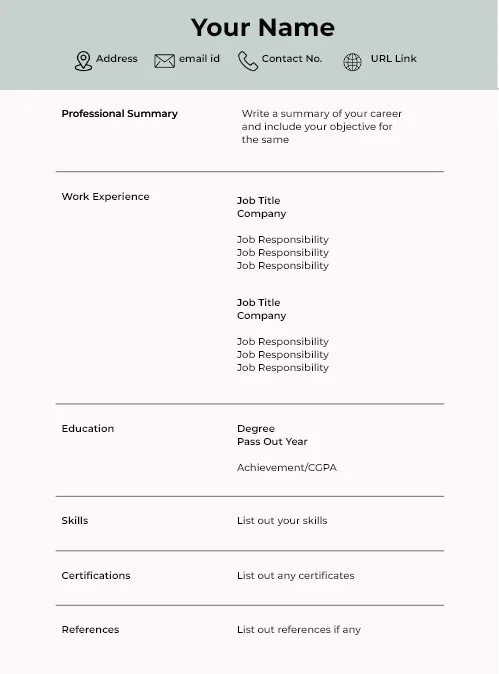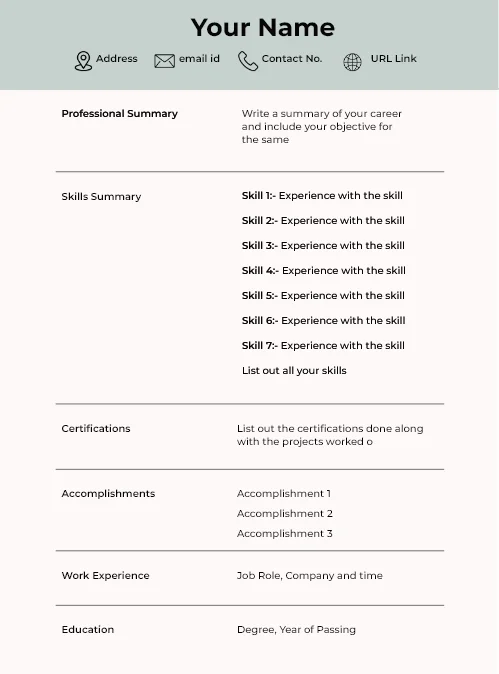
How to Build The Perfect Resume in 2024?
Get the Top Tips for Resume Preparation on this page.

 0
0
Notifications Mark All Read

Get the Top Tips for Resume Preparation on this page.

A good resume is your key to getting that dream job. Your resume serves as an introduction to the employers and conveys your skills and knowledge to the interviewer.
Most companies have a round called resume shortlisting. This is done by an ATS or Applicant Tracking System. Where an AI-based application scans your resume and gives it a score. Based on the score then your profile is shortlisted for further rounds.
Therefore it is very important that you build a proper resume that is both ATS friendly and readable for any interviewer. In this page, you will find all the important resume preparation tips.
| CV or Curriculum Vitae | Resume |
|---|---|
| gives your entire career history | gives an overview of your skills relevant for the job |
| focuses more on your academic and career accomplishments | focuses more on your skills |
| used when applying for fellowship, grants or any academic position. | used when applying for jobs in industry. |
| there is no fixed length | it should not be more than one to one and a half |
Before you start your resume preparation, you should know about the different types of resume. Below we have listed the different resume types and their pros and cons.
Resume types are widely categorized into three categories, which are:-
Go through each and pick out the best template for your resume preparation.

A chronological resume lists your work experience in reverse order, i.e., your latest job will be listed first. This includes the company, job role, date of joining and a brief summary of your job responsibilities.
A functional resume focuses on the skills of a person rather than past work experience. This format lists skills and work experience together. It highlights an individuals talent and skill sets rather than previous work experience.


A combination resume or hybrid resume combines both chronological and functional resume. It includes emphasizes on both skills as well as work experience in a reverse chronological order.


STEP 1: Decide on a resume layout:
This is the first phase, which begins with the structure you wish to use to construct your resume. Take some time to consider this option.


STEP 1: Decide on a resume layout:
This is the first phase, which begins with the structure you wish to use to construct your resume. Take some time to consider this option.
STEP 2: Provide your name and contact information.
This field contains the following information and serves as the resume’s heading.


STEP 2: Provide your name and contact information.
This field contains the following information and serves as the resume’s heading.
STEP 3: Write a resume/career objective.
A Professional Objective/Resume Objective statement identifies either a specific job or a general career path that you intend to pursue. It functions as a resume pitch.


STEP 3: Write a resume/career objective.
A Professional Objective/Resume Objective statement identifies either a specific job or a general career path that you intend to pursue. It functions as a resume pitch.
Step 4: Work Experience
This section, titled “Work Experience” or “Professional Experience,” should focus on your general skills in a way that demonstrates how your previous experience might benefit an employer’s future plans.


Step 4: Work Experience
This section, titled “Work Experience” or “Professional Experience,” should focus on your general skills in a way that demonstrates how your previous experience might benefit an employer’s future plans.

Step 5: Education Details
If you’re still in school or have recently graduated, your education is most likely your most valuable possession. In reverse chronological order, describe your educational background. Taking the most recent degree first.

Step 5: Education Details
If you’re still in school or have recently graduated, your education is most likely your most valuable possession. In reverse chronological order, describe your educational background. Taking the most recent degree first.

STEP 6: Skills
You can describe your technical abilities in this field. When writing about your technical skills, use action verbs because recruiters and applicant tracking systems hunt for these resume keywords.

STEP 6: Skills
You can describe your technical abilities in this field. When writing about your technical skills, use action verbs because recruiters and applicant tracking systems hunt for these resume keywords.

Step 7: Projects & Certifications
You might list any projects or qualifications you have earned throughout your career in this section. Projects and certifications are very important in a resume:

Step 7: Projects & Certifications
You might list any projects or qualifications you have earned throughout your career in this section. Projects and certifications are very important in a resume:

Step 8: Additional Sections
You can further add “additional sections” including other relevant details about yourself. Including hobbies, publications, etc.

Step 8: Additional Sections
You can further add “additional sections” including other relevant details about yourself. Including hobbies, publications, etc.
These are the basic steps for resume preparation. You can follow them to create a perfect resume that is ATS friendly and will help you land good jobs.
Find links for sample resume below:-

As previously said, an excellent professional summary should entice an employer to read the rest of your resume. If it succeeds in doing so, it has served its goal.
However, this is easier said than done, as condensing the most exciting aspects of your job into a 3-5 bullet point synopsis might be difficult.

The schooling part is one of the most straightforward to write. If you follow these basic procedures, you should be alright in most cases:

If you’ve just graduated from high school, you don’t have much experience. Being young, though, is not a hindrance. It all boils down to how you look at your current situation.
As a student or recent graduate, your employment experience should come after the education part. It’s not like you’ve been sitting around doing nothing for years.

The talents resume section may appear basic at first glance. When you start digging into the details, you’ll quickly discover that you have a slew of practical questions that will necessitate some research –– both on yourself and on the work.
Researching the job posting, the firm, and its work culture, as well as asking yourself questions, is an excellent method to start preparing for writing the skill section of your resume.

You might just call the section “Hobbies.”
Instead of putting too many hobbies and interests on your resume, limit yourself to 4-5 depending on the criteria outlined in the section “What hobbies and interests should you include?”
Consider a skill or accomplishment that best demonstrates your enthusiasm.
The goal is to give them a glimpse into your character. Don’t go all out with organizations who have a particularly formal company culture, though.

You can either include them in your resume or attach them to your job application as a separate document.
In any case, you should decide how many references you want to add first. This is dependent on your level of experience.
Never say never. The hiring manager may contact only one or two of your references, or all of them. Make sure they have a lot of options in case one of them is unavailable.
Answer:-
Don’t worry if you don’t know where to start. PrepInsta will walk you through each step of the resume writing process, one area at a time.
For further information, see our resume instructions or click the Get Prime icon below. On PrepInsta Prime, you may go through the entire resume preparation course module to develop an impressive and strong resume that will help you land the perfect job you’ve been looking for.
Answer:-
Form and content are the deciding factors. First, make your resume stand out while remaining professional.
The most straightforward approach to do so is to use a resume builder and select a professionally prepared template that is appropriate for your industry and career. Second, make your CV stand out by emphasising your best qualities.
Answer:-
Your cover letter is a one-page document that you include with your resume when applying for a job. It can take numerous forms, including text in the body of an email, a completed internet form, or a standalone PDF document.
What is the function of the cover letter in today’s world? Recruiters will not always read your cover letter, which is a bit depressing. At the same time, including one is still considered a favour, especially at smaller organisations where each application is more likely to be carefully reviewed. Finally, a well-written cover letter gives you the chance to stand out.
Prepare for the interview process in both Service and Product Based companies along with Group Discussion, Puzzles, Resume Building, HR, MR and Technical Interviews.
hello
Hey there, Kindly message us at 8448440710 Whatsapp number, our mentors will guide you further with placement preparation and assistance.